RANSOM_CRYPWALL.YUYAHM
Win32/Filecoder.CryptoWall.G (ESET-NOD32);
Windows


Threat Type: Trojan
Destructiveness: No
Encrypted:
In the wild: Yes
OVERVIEW
Downloaded from the Internet, Dropped by other malware
This Trojan arrives on a system as a file dropped by other malware or as a file downloaded unknowingly by users when visiting malicious sites.
It connects to a website to send and receive information.
It modifies the Internet Explorer Zone Settings.
It deletes the initially executed copy of itself.
TECHNICAL DETAILS
292,352 bytes
EXE
Yes
07 Feb 2016
Encrypts files, Compromises system security
Arrival Details
This Trojan arrives on a system as a file dropped by other malware or as a file downloaded unknowingly by users when visiting malicious sites.
Installation
This Trojan drops the following copies of itself into the affected system:
- %Application Data%\{random characters}\{random characters}.exe
(Note: %Application Data% is the Application Data folder, where it usually is C:\Documents and Settings\{user name}\Application Data on Windows 2000, Windows Server 2003, and Windows XP (32- and 64-bit); C:\Users\{user name}\AppData\Roaming on Windows Vista (32- and 64-bit), Windows 7 (32- and 64-bit), Windows 8 (32- and 64-bit), Windows 8.1 (32- and 64-bit), Windows Server 2008, and Windows Server 2012.)
It drops the following files:
- %User Startup%\INSTRUCTIONS_{RANDOM HEX}.html
- %User Startup%\INSTRUCTIONS_{RANDOM HEX}.png
- %User Startup%\INSTRUCTIONS_{RANDOM HEX}.txt
- {Drive Letter}:\INSTRUCTIONS_{RANDOM HEX}.png
(Note: %User Startup% is the current user's Startup folder, which is usually C:\Documents and Settings\{user}\Start Menu\Programs\Startup on Windows 2000 and XP, and C:\Documents and Settings\{User name}\Start Menu\Programs\Startup on Windows Vista, 7, and 8.)
It drops and executes the following files:
- %Desktop%\INSTRUCTIONS_{RANDOM HEX}.html
- %Desktop%\INSTRUCTIONS_{RANDOM HEX}.png
- %Desktop%\INSTRUCTIONS_{RANDOM HEX}.txt
(Note: %Desktop% is the desktop folder, where it usually is C:\Documents and Settings\{user name}\Desktop in Windows 2000, Windows Server 2003, and Windows XP (32- and 64-bit); C:\Users\{user name}\Desktop in Windows Vista (32- and 64-bit), Windows 7 (32- and 64-bit), Windows 8 (32- and 64-bit), Windows 8.1 (32- and 64-bit), Windows Server 2008, and Windows Server 2012.)
It adds the following processes:
- svchost.exe
It is injected into the following processes running in memory:
- created svchost.exe
Autostart Technique
This Trojan adds the following registry entries to enable its automatic execution at every system startup:
HKEY_CURRENT_USER\Software\Microsoft\
Windows\CurrentVersion\Run
{random characters} = "%Application Data%\{random characters}\{random characters}.exe"
Backdoor Routine
This Trojan connects to the following websites to send and receive information:
- {BLOCKED}relampago.com.br/4jiPBG.php
- {BLOCKED}ekinci.biz/Hg3V8b.php
- {BLOCKED}gou.com/Pfy2Qs.php
- {BLOCKED}info/zYNKoq.php
- {BLOCKED}.sk/g3lfoj.php
- {BLOCKED}.com.br/SGJ_Fr.php
- {BLOCKED}ka.com.ua/tjhW2B.php
- {BLOCKED}p.pl/Si0cCJ.php
- {BLOCKED}ness.be/fYvA5U.php
- {BLOCKED}trade.tk/12fDze.php
- {BLOCKED}bear.net/MRGKAC.php
- {BLOCKED}rtners.it/Dd6VPR.php
- {BLOCKED}kz/yMZFGp.php
- {BLOCKED}o.kz/LUoMqa.php
- {BLOCKED}ness.be/isB2Ac.php
- {BLOCKED}ster.kz/vUn1wz.php
- {BLOCKED}-anything.tk/PsdO76.php
- {BLOCKED}ka.com.ua/MVc9hg.php
- {BLOCKED}ightcr.com/tHja9Z.php
- {BLOCKED}y.kz/7_9SR6.php
- {BLOCKED}rticle.com/fZ1Y8M.php
- {BLOCKED}nat.ro/ZeNpML.php
- {BLOCKED}ldirim.net/zn9mur.php
- {BLOCKED}le.com.br/XAT7zH.php
- {BLOCKED}experto.pe/zOesbw.php
- {BLOCKED}orts4u.com/dfgOwA.php
- {BLOCKED}.pl/fFe_xr.php
- {BLOCKED}assescorts4u.com/Snuxg7.php
- {BLOCKED}entod.ua/I35pl6.php
- {BLOCKED}.kz/TSOXQL.php
- {BLOCKED}o.com.br/4A0Hw5.php
- {BLOCKED}dedon.com/CBRrYv.php
- {BLOCKED}gp.ir/U_ABoi.php
- {BLOCKED}obirlik.com/UxAK5e.php
- {BLOCKED}fishing.com/CXjq48.php
- {BLOCKED}music.nl/yBDEMc.php
- {BLOCKED}osautomotivos.com.br/KMYz1s.php
- {BLOCKED}ucatangob.mx/UIagAy.php
- {BLOCKED}sa.com/Zoe2aN.php
- {BLOCKED}rehberi.com/6JQEva.php
- {BLOCKED}hina.com/NSrcQE.php
- {BLOCKED}ouse.nl/iMVfC4.php
- {BLOCKED}radydrewniane.pl/Fcb7VZ.php
- {BLOCKED}anch.us/PtAg1I.php
- {BLOCKED}gloan.com/1vR9hu.php
- {BLOCKED}e-veza.sk/Owm50c.php
- {BLOCKED}om.tr/prkdzF.php
- {BLOCKED}rga.co/L8HU29.php
- {BLOCKED}lescorts4u.com/XqVFBm.php
- {BLOCKED}odalari.net/GnOLXh.php
- {BLOCKED}everka.sk/6RGZgC.php
- {BLOCKED}ociort.ro/6sZTLc.php
Web Browser Home Page and Search Page Modification
This Trojan modifies the Internet Explorer Zone Settings.
Other Details
This Trojan encrypts files with the following extensions:
- pdf
- pot
- xlt
- pps
- xlw
- dot
- rtf
- ppt
- xls
- doc
- xml
- htm
- html
- hta
- zip
- dvr-ms
- wvx
- wmx
- wmv
- wm
- mpv2
- mpg
- mpeg
- mpe
- mpa
- mp2v
- mp2
- m1v
- IVF
- asx
- asf
- wax
- snd
- rmi
- m3u
- au
- aiff
- aifc
- aif
- midi
- mid
- wma
- wav
- m p3
- wmf
- tiff
- tif
- rle
- png
- jpeg
- jpe
- jpg
- jfif
- ico
- gif
- emf
- dib
- bmp
It deletes the initially executed copy of itself
NOTES:
It searches all drives for files to encrypt except CD_ROM drive.
It avoids encrypting files with the following extensions:
- vb
- scr
- reg
- pif
- msi
- exe
- com
- cmd
- bat
- bas
It renames encrypted files using the following names:
- {5 to 10 alphanumeric characters}.{2 to 5 alphanumeric characters}
It displays the following ransom notes:
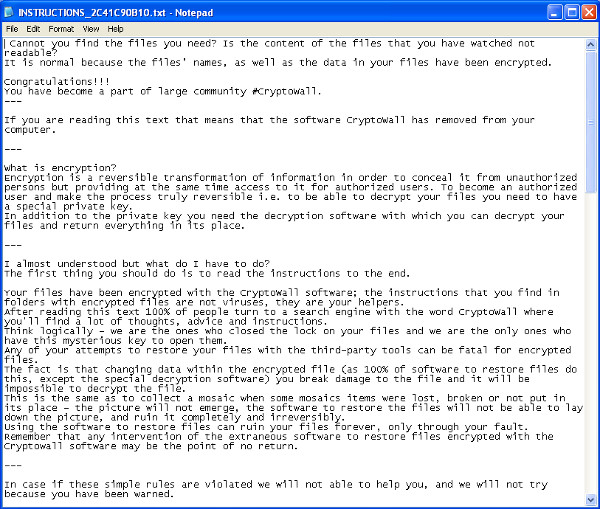
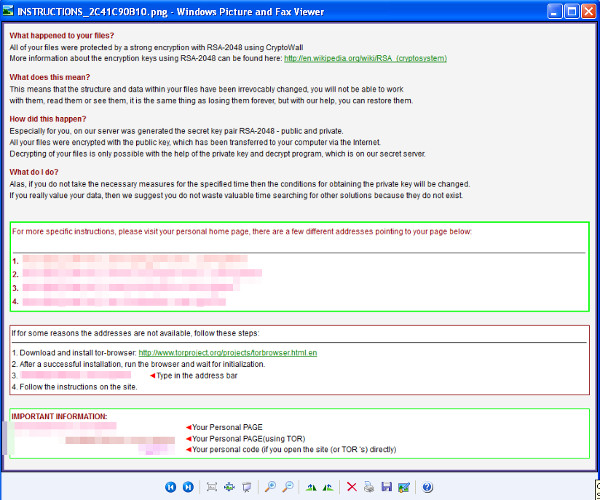 http://documents.trendmicro.com/images/TE/inst_html_1.jpg>
http://documents.trendmicro.com/images/TE/inst_html_1.jpg>

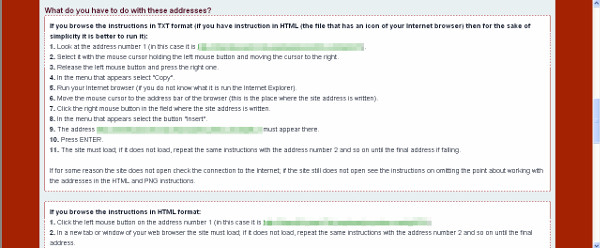
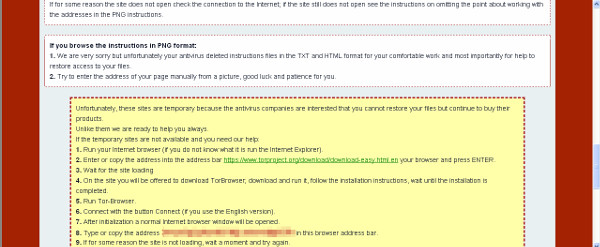
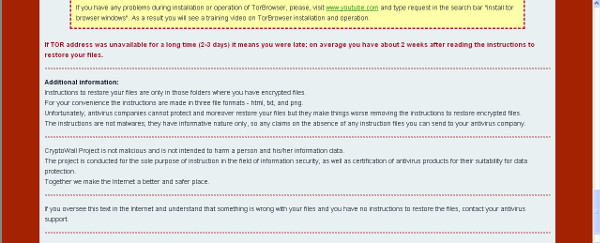

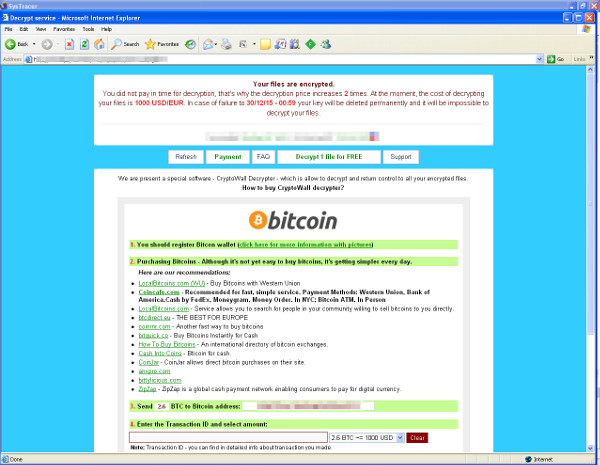
SOLUTION
9.800
12.300.05
27 Jan 2015
12.301.00
28 Jan 2015
Step 1
Before doing any scans, Windows XP, Windows Vista, and Windows 7 users must disable System Restore to allow full scanning of their computers.
Step 2
Note that not all files, folders, and registry keys and entries are installed on your computer during this malware's/spyware's/grayware's execution. This may be due to incomplete installation or other operating system conditions. If you do not find the same files/folders/registry information, please proceed to the next step.
Step 3
Restart in Safe Mode
Step 4
Delete this registry value
Important: Editing the Windows Registry incorrectly can lead to irreversible system malfunction. Please do this step only if you know how or you can ask assistance from your system administrator. Else, check this Microsoft article first before modifying your computer's registry.
- In HKEY_CURRENT_USER\Software\Microsoft\Windows\CurrentVersion\Run
- {random characters} = "%Application Data%\{random characters}\{random characters}.exe"
- {random characters} = "%Application Data%\{random characters}\{random characters}.exe"
Step 5
Search and delete this file
- %Application Data%\{random characters}\{random characters}.exe
- %User Startup%\INSTRUCTIONS_{RANDOM HEX}.html
- %User Startup%\INSTRUCTIONS_{RANDOM HEX}.png
- %User Startup%\INSTRUCTIONS_{RANDOM HEX}.txt
- %Desktop%\INSTRUCTIONS_{RANDOM HEX}.html
- %Desktop%\INSTRUCTIONS_{RANDOM HEX}.png
- %Desktop%\INSTRUCTIONS_{RANDOM HEX}.txt
- {Drive Letter}:\INSTRUCTIONS_{RANDOM HEX}.png
Step 6
Restart in normal mode and scan your computer with your Trend Micro product for files detected as RANSOM_CRYPWALL.YUYAHM. If the detected files have already been cleaned, deleted, or quarantined by your Trend Micro product, no further step is required. You may opt to simply delete the quarantined files. Please check this Knowledge Base page for more information.
Step 7
Reset Internet security settings
Step 8
Scan your computer with your Trend Micro product to delete files detected as RANSOM_CRYPWALL.YUYAHM. If the detected files have already been cleaned, deleted, or quarantined by your Trend Micro product, no further step is required. You may opt to simply delete the quarantined files. Please check this Knowledge Base page for more information.
Did this description help? Tell us how we did.

